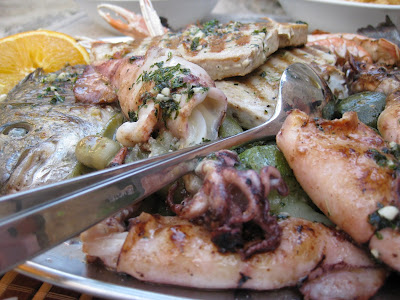 |
| The Bay of Kotor |
We were up nice 'n' early for our tour; it was neat to walk against the stream of commuters to Dubrovnik's Old Town at that hour. There was a bit of a mix-up with the tour, such that we ended up on a bus with thirty or so French-speaking Belgians. Luckily there were two guides, so the half dozen English speakers were segregated to the back of the bus for translations in the silences. As both Tea and I understand French reasonably well -- particularly the guide's perfectly enunciated Montenegrin-school French -- we got the best of both worlds, with quick questions to our guide where we faltered. (Incidentally, we both agreed that what I'm assuming was
Walloon French is
very difficult to understand. Before I discovered they were Belgians, I seriously suspected that their native language wasn't French, and that they'd simply booked said tour for its accessibility, etc.)
 |
| The Cathedral of Saint Tryphon, in Kotor |
Let there be no doubt: the Belgians know how to vacation. After clearing the two border crossings -- Croatia's and Montenegro's -- the agenda called for a quick stop at a petrol station to pick up our local guide; 15 minutes for the toilet, a stretch, etc. I blink, and the station patio bar is full of Belgian couples raising glasses of the local
Nik Gold. (Obligatory review: I tried Nikšićko pivo in Budva later that day; unpleasantly metallic at the outset, with no finish -- the latter being a selling point, according to the warped reality of beer advertisers.) And this continued at each of the stops! Živjeli!
Montenegro is, simply, beautiful. Driving around
the Bay of Kotor was incredible. Cypress trees darken the awesome
Dinarides -- hence the country's name, "black mountains" -- leading down to the mirror-like, deep blue bay; it actually resembles a fjord, blocking all wind from the Adriatic. With towns and villages at the water's edge -- the best defence against the main threat of the time: invading
Ottomans from the mountains --
it really reminded me of a lush Lake Como; indeed, the Dinarides (is it just me, or does that word conjure up this epic mix of
Easy Rider and dinosaurs?) are properly called the Dinaric Alps.
 |
| You can just make out the city wall above |
The city of Kotor was our first significant stop. Words fail me. That wall 'round the old port, rising up the mountains in the most imposing fashion, was the highlight of the tour. Unfortunately, given the lushness of the terrain, I feel my pictures too have failed to capture it. (This will probably sound simple and odd, but, staring up at that wall, I felt like the greatest of cities from the
Romance of the Three Kingdoms video game were alive before me; ah, a childhood bowed before Nintendo.)
This trip has really illuminated how paths diverged following the dissolution of
the Socialist Federal Republic of Yugoslavia, and on a spectrum of Croatia to Bosnia, a good example of mixed blessings is Montenegro generally, and the route to our other stop,
Budva, specifically.
 |
| Relaxing in Budva |
The division of
the South Slavic language known as Serbo-Croatian was largely a political construct, and while Montenegrins understand Croatian,
officially they use a Cyrillic alphabet, whereas the latter use a Latin one. (Incidentally, our guide admitted that she struggles with official, largely government-related, correspondence, as the reality of Montenegro's reliance on tourism means that a Latin alphabet carries the day.) I raise this because our guide pointed out that, on said road to Budva, and throughout the town itself, it's the Russian alphabet, not the Serbian one, on the road signs and shop fronts. This, the large mansions (outside
UNESCO protected areas, at least), and (abandoned, in many cases) factories blighting the greenery, reflect Russian exploitation of a newly-independent (since 2006), but poor, country. (For example, unable to afford a currency of their own, Montenegro requested, and received, permission to use the euro, even though they aren't part of the Union.)
I've always had difficulty putting news from this region (e.g.,
Kosovo's declaration of years past) in context, so it was particularly fascinating and rewarding for me to learn about its history in such beautiful surroundings. Tour guides are no different from any of us, of course, burdened with a set of biases; still, for me, it's tough to beat a few hours with a good storyteller.
Check out
our album for more pictures from the tour.




































